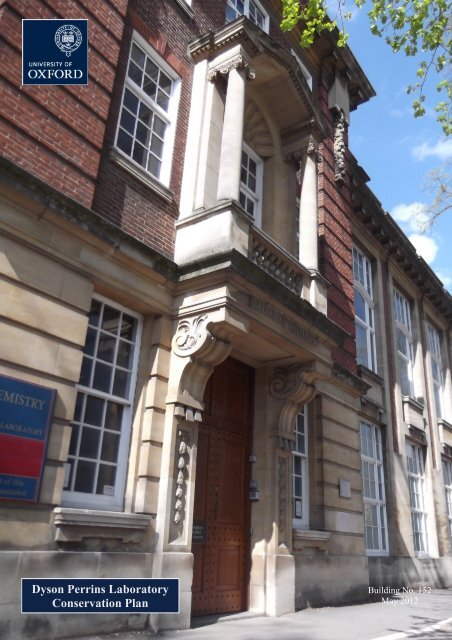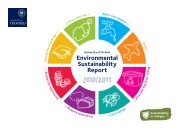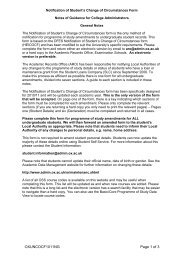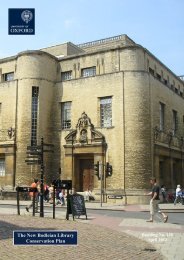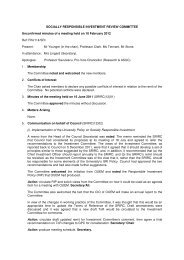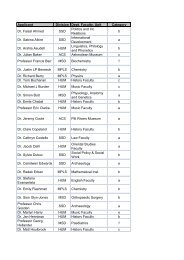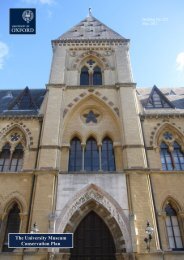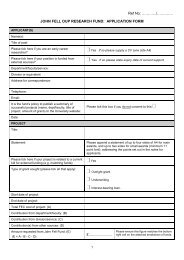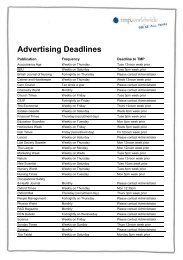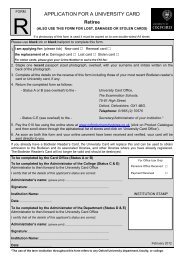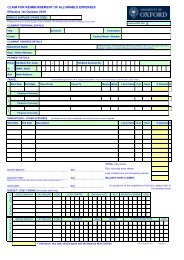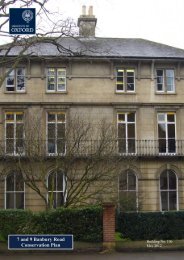Dyson Perrins Laboratory - Central Administration - University of ...
Dyson Perrins Laboratory - Central Administration - University of ...
Dyson Perrins Laboratory - Central Administration - University of ...
- No tags were found...
Create successful ePaper yourself
Turn your PDF publications into a flip-book with our unique Google optimized e-Paper software.
<strong>Dyson</strong> <strong>Perrins</strong> <strong>Laboratory</strong>Building No. 152The <strong>Dyson</strong> <strong>Perrins</strong> <strong>Laboratory</strong>, Oxford 1ConservationConservation Plan,PlanMay 2012May 2012
Oxford <strong>University</strong>Estates ServicesFirst draft May 2012The <strong>Dyson</strong> <strong>Perrins</strong> <strong>Laboratory</strong>, Oxford 2Conservation Plan, May 2012
THE RADCLIFFE CAMERA, OXFORDCONSERVATION PLANCONTENTS1 INTRODUCTION 71.1 Purpose <strong>of</strong> the Conservation Plan 71.2 Scope <strong>of</strong> the Conservation Plan 81.3 Existing Information 91.4 Methodology 91.5 Constraints 92 UNDERSTANDING THE SITE 132.1 History <strong>of</strong> the Site and <strong>University</strong> 132.2 History <strong>of</strong> the <strong>Dyson</strong> <strong>Perrins</strong> <strong>Laboratory</strong> 143 SIGNIFICANCE OF THE DYSON PERRINS LABORATORY 273.1 Significance as part <strong>of</strong> South Parks Road, Holywell Ward, and the<strong>University</strong> Science Area273.2 Architectural Significance 293.3 Historical Significance 313.4 Archaeological Significance 324 VULNERABILITIES 354.1 Accessibility 354.2 Maintenance 364.2.1 Exterior Elevations and Setting 364.2.2 Interior Spaces 375 CONSERVATION POLICY 41The <strong>Dyson</strong> <strong>Perrins</strong> <strong>Laboratory</strong>, Oxford 3Conservation Plan, May 2012
6 BIBLIOGRAPHY 477 APPENDICES 53Appendix 1: Listed Building Description 53Appendix 2: Chronology <strong>of</strong> the <strong>Dyson</strong> <strong>Perrins</strong> <strong>Laboratory</strong> 57Appendix 3: Checklist <strong>of</strong> Significant Features 61Appendix 4: Floor Plans 638 ANNEXES 71Annex 1: The Development <strong>of</strong> the <strong>University</strong> Science Area 71The <strong>Dyson</strong> <strong>Perrins</strong> <strong>Laboratory</strong>, Oxford 4Conservation Plan, May 2012
The <strong>Dyson</strong> <strong>Perrins</strong> <strong>Laboratory</strong>, Oxford 5Conservation Plan, May 2012
THIS PAGE HAS BEEN LEFT BLANKThe <strong>Dyson</strong> <strong>Perrins</strong> <strong>Laboratory</strong>, Oxford 6Conservation Plan, May 2012
The Conservation Plan should form the basis for the <strong>Dyson</strong> <strong>Perrins</strong> <strong>Laboratory</strong>’sConservation Policy and exists as part <strong>of</strong> an ongoing process. It will be renewed and updatedat least every five years or following any major alterations or legislative changes.Figure 1. Map showing the <strong>Dyson</strong> <strong>Perrins</strong> <strong>Laboratory</strong>. The original (1913-16) portionis highlighted in red, the 1920-22 portion in blue, and later additions in green.Orientated with North at the top <strong>of</strong> the image1.2 Scope <strong>of</strong> the Conservation PlanThis Conservation Plan will cover the interior and the exterior <strong>of</strong> the listed portions <strong>of</strong> the<strong>Dyson</strong> <strong>Perrins</strong> <strong>Laboratory</strong>, those being the original structure (1913-16) and the 1920-22extension to the east, in reality the conclusion <strong>of</strong> the original scheme (those portionshighlighted in red and blue in Figure 1). 1 It will not cover those later extensions not coveredby the listed building description (Appendix 1), notably the 1939-40 and 1956-58 extensionsto the north.This plan is not a catalogue and to facilitate its practical use will concentrate only on the mostvulnerable aspects <strong>of</strong> significance, suggesting how they should be approached and conservedin the future. A brief list <strong>of</strong> the most significant architectural features can be found inAppendix 3 and should be referred to when planning any repair or alteration work.1Note: The listed building description misidentifies the westernmost section (presumably due to itsheterogeneity) as the 1920-22 addition and the eastern and western wings as belonging to a single phase <strong>of</strong>construction.The <strong>Dyson</strong> <strong>Perrins</strong> <strong>Laboratory</strong>, Oxford 8Conservation Plan, May 2012
1.3 Existing InformationA Conservation Plan has not previously been produced for the <strong>Dyson</strong> <strong>Perrins</strong> <strong>Laboratory</strong>;however, there are various forms <strong>of</strong> existing information available:The relatively-detailed 2001 listed building description (Appendix 1) is the logical startingpoint for this plan as it lists the heritage asset’s main features and briefly assesses itsarchitectural significance.Various planning applications have been made throughout the building’s history, providing afragmentary indication <strong>of</strong> the changes that have occurred over time.There are several published books and articles that cover the development <strong>of</strong> organicchemistry at Oxford. Whilst as a general rule they tend to concentrate more on science thanon history, these documents nevertheless provide a valuable resource for studying the <strong>Dyson</strong><strong>Perrins</strong> <strong>Laboratory</strong>.The Oxford <strong>University</strong> Archives and the Estates Services archives contain various usefuldocuments for studying the history <strong>of</strong> the <strong>Dyson</strong> <strong>Perrins</strong> <strong>Laboratory</strong> and these have kindlybeen made available for the composition <strong>of</strong> this document.The plan draws on statutory guidance from NPPF prepared by HM’s Department forCommunities and Local Government in March 2012.1.4 MethodologyThe Conservation Plan is a document that assesses the current and predicted conservationneeds <strong>of</strong> the <strong>Dyson</strong> <strong>Perrins</strong> <strong>Laboratory</strong> and attempts to address them with a view towardsmaintaining or increasing the significance <strong>of</strong> the heritage asset. Its formulation to supersedeany existing literature is a response to the requirements <strong>of</strong> NPPF, and it is prepared inaccordance with the policies contained therein.1.5 ConstraintsThe <strong>Dyson</strong> <strong>Perrins</strong> and its environs are subject to various constraints imposed by Oxford CityCouncil: CP.3 – Limiting the Need to Travel: New development will be limited to accessiblelocations on previously developed sites. HE.9 – High Building Areas: Planning permission will not be granted for anydevelopment within a 1,200 metre radius <strong>of</strong> Carfax which exceeds 18.2m in height, exceptfor minor elements <strong>of</strong> no bulk.The <strong>Dyson</strong> <strong>Perrins</strong> <strong>Laboratory</strong>, Oxford 9Conservation Plan, May 2012
TR.3, TR.11, TR.12 – Car Parking Standards: The City Council will not allow anysignificant increase in the overall number <strong>of</strong> car-parking spaces in the Transport <strong>Central</strong>Area or development that provides an inappropriate level <strong>of</strong> car-parking spaces. It willattempt to reduce the level <strong>of</strong> non-residential car parking. The City <strong>of</strong> Oxford Smoke Control Order No. 2: It is an <strong>of</strong>fence to emit smoke from thechimney <strong>of</strong> a building, from a furnace, or from any fixed boiler if located in a designatedsmoke control area.The <strong>Dyson</strong> <strong>Perrins</strong> <strong>Laboratory</strong>, Oxford 10Conservation Plan, May 2012
The <strong>Dyson</strong> <strong>Perrins</strong> <strong>Laboratory</strong>, Oxford 11Conservation Plan, May 2012
THIS PAGE HAS BEEN LEFT BLANKThe <strong>Dyson</strong> <strong>Perrins</strong> <strong>Laboratory</strong>, Oxford 12Conservation Plan, May 2012
2 UNDERSTANDING THE SITE2.1 History <strong>of</strong> the Site and <strong>University</strong> 2The site <strong>of</strong> Oxford has had sporadic settlement since the Neolithic period. Bronze Agebarrows have been found in the <strong>University</strong> Parks (linear barrow cemetery) and in the ScienceArea (double-ditched barrow). Oxford has had a continuous history <strong>of</strong> occupation since atleast the 8 th Century AD. The <strong>University</strong> <strong>of</strong> Oxford itself has a long-standing tradition <strong>of</strong>exceptional education. Able to trace its roots to the 11 th Century, it is known to be the oldestuniversity in the English-speaking world.The site upon which the <strong>Dyson</strong> <strong>Perrins</strong> <strong>Laboratory</strong> now stands is situated in the northeast <strong>of</strong>the city <strong>of</strong> Oxford. This area was developed in the 19 th Century, notably with the construction<strong>of</strong> the <strong>University</strong> Museum on the eastern side <strong>of</strong> Parks Road in 1855-60 and the construction<strong>of</strong> Keble College on the western side <strong>of</strong> Parks Road in 1868-70.The 91-acre site now occupied by the <strong>University</strong> Museum, the Science Area, and the<strong>University</strong> Parks was purchased by the <strong>University</strong> from Merton College in stages between1853 and 1864. The first plans for the <strong>University</strong> Parks were presented to the <strong>University</strong> inJune 1863, but these were rejected, and it was not until 1865 that £500 was allocated for thepurchase <strong>of</strong> trees and shrubberies. Even before this point the space allocated to the Parks wasdiminished by the allocation in 1853 <strong>of</strong> 4 acres in its southern portion (followed by another 4acres in 1854) for the <strong>University</strong> Museum (1855-60), and this southern expanse underwentnear-continuous development throughout the second half <strong>of</strong> the 19 th Century.The <strong>University</strong> Science Area was initially developed as a series <strong>of</strong> extensions to the<strong>University</strong> Museum with: the construction <strong>of</strong> the original Clarendon Physics <strong>Laboratory</strong> (nowembedded within the Robert Hooke (Old Earth Sciences) Building) on its northwest side in1867-69 (extended in 1946-58); the construction <strong>of</strong> the Pitt Rivers Museum on the east in1885-86; the addition <strong>of</strong> Jackson’s Radcliffe Science Library to the south in 1898-1900(extended in 1933-34); and the extension <strong>of</strong> the Department <strong>of</strong> Zoology (now housingAtmospheric Physics) and Stevenson and Redfern’s Morphology <strong>Laboratory</strong> to the north in1898-1901. 3Further science buildings were constructed in this precinct from the last quarter <strong>of</strong> the 19 thCentury. Many <strong>of</strong> these were originally free-standing, but continued development has createdan increasingly interconnected science district. The near-continuous history <strong>of</strong> developmentin the area has created a crowded space at the south <strong>of</strong> the Park precinct and along SouthParks Road. It is the main centre for the study <strong>of</strong> sciences within the <strong>University</strong>, and is nowknown as the <strong>University</strong> Science Area.2 A short chronology <strong>of</strong> the <strong>Dyson</strong> <strong>Perrins</strong> <strong>Laboratory</strong> can be found in Appendix 2.3 A brief overview <strong>of</strong> the development <strong>of</strong> the Science Area can be found in Annexe 1.The <strong>Dyson</strong> <strong>Perrins</strong> <strong>Laboratory</strong>, Oxford 13Conservation Plan, May 2012
2.2 History <strong>of</strong> the <strong>Dyson</strong> <strong>Perrins</strong> <strong>Laboratory</strong>The <strong>Dyson</strong> <strong>Perrins</strong> <strong>Laboratory</strong> has its origins in the 1909 Committee on <strong>University</strong> Teachingin Chemistry. Historically Chemistry teaching had been confined to various collegelaboratories. A <strong>University</strong> Chemistry <strong>Laboratory</strong> was constructed alongside the <strong>University</strong>Museum in 1855-60. This was known as the Abbot’s Kitchen, being based on the fourteenthcenturyAbbot’s Kitchen at Glastonbury. Unsurprisingly, being based on mediaevalecclesiastical models rather than the purpose-built laboratories at that time appearing on theContinent, this building was quickly insufficient for its needs. It was heavily extended in1878, with a far-more-practical teaching laboratory, which, whilst no longer up to modernstandards, remains in use to this day. 4 This alleviated the problem somewhat but by the earlytwentieth century chemistry teaching and research in Oxford was woefully inadequate, andhad long since been overtaken in academic stature by Manchester <strong>University</strong>.The 1909 Committee on <strong>University</strong> Teaching in Chemistry reported that ‘the provision madeat present by the <strong>University</strong> for the teaching and study <strong>of</strong> chemistry is inadequate, both inrespect <strong>of</strong> the staff and as regards laboratory accommodation…The committee recommendsas urgently needed: Two <strong>University</strong> Pr<strong>of</strong>essors at £900 a year, one assigned to the subject <strong>of</strong>organic chemistry and the other to that <strong>of</strong> inorganic chemistry.’ The Committeerecommended that a new building should be constructed to house the two laboratories andthat it should be located on <strong>University</strong> property, close to the <strong>University</strong> Museum, and withsufficient space for future expansion. 5The Hebdomadal Council estimated that £25,000 would be required to construct the requiredlaboratory and it petitioned the <strong>University</strong> Endowment Fund in March 1910 for the necessaryresources. The funds were by no means easily obtained. It was not until William Odling, theWaynflete Pr<strong>of</strong>essor <strong>of</strong> Chemistry, announced his retirement in 1912 that the conservative<strong>University</strong> Chest would meet the requests <strong>of</strong> the liberal Hebdomadal Council. It was agreedthat a new laboratory would be constructed and the <strong>University</strong> Chest made £15,000 available.An organic chemist, W.H. Perkin held the Chair <strong>of</strong> Chemistry at Manchester <strong>University</strong>, theleading chemistry department in Great Britain, and in 1909 had designed, with PaulWaterhouse, Manchester’s Morley <strong>Laboratory</strong>. The specifications for this were based onPerkin’s experience <strong>of</strong> Adolf von Baeyer’s laboratory in Munich, where he had worked as adoctoral student. Perkin was initially invited to Oxford in 1912 as an Elector for Odling’sreplacement, though it was quickly made clear that he was the preferred option for theWaynflete Chair, prompting him to resign his Electorship to stand as a candidate. 6 Researchwas Perkin’s first priority and, when the Electors <strong>of</strong>fered the rôle to him in November 1912,he accepted on the condition that he should be provided with a new laboratory and that in themeantime he should be given a fully-equipped temporary laboratory in the <strong>University</strong>Museum.4 Inorganic Chemistry <strong>Laboratory</strong>: Conservation Plan (Estates Services, January 2012).5 Curtis, R., Leith, C., Nall, J., and Jones, J., The <strong>Dyson</strong> <strong>Perrins</strong> <strong>Laboratory</strong> and Oxford Organic Chemistry1916-2004 (Oxford, 2008) 15-16.6 Ibid, 17.The <strong>Dyson</strong> <strong>Perrins</strong> <strong>Laboratory</strong>, Oxford 14Conservation Plan, May 2012
Perkin came to his temporary laboratory in Oxford in January 1913. He immediately setabout securing his new laboratory, and in February 1913 invited Oxonians to Manchester toview the Morley <strong>Laboratory</strong>. Whilst it was intended that Oxford’s new laboratory wouldhouse both organic and inorganic chemistry, the chair in inorganic chemistry had not beenappointed and Perkin’s single-mindedness and energy ensured that the new building would infact house only organic chemistry. Perkin engaged the architectural services <strong>of</strong> the Balliolalumnus Paul Waterhouse, who had served him so ably in Manchester. They set aboutdesigning a building about a third the size <strong>of</strong> the Morley <strong>Laboratory</strong>, with sufficient spacebeing left around the site for future expansion.Figure 2. Waterhouse’s scheme for the laboratory. Note the right-hand (eastern) wingwas not built until the second stage <strong>of</strong> construction in 1920-22, and was constructedwith an additional bay and slightly different windows than as shownPerkin and Waterhouse’s scheme was estimated to cost about £20,000. This was significantlyless than the £25,000 originally estimated by the Hebdomadal Council in 1910, but with the<strong>University</strong> Chest only <strong>of</strong>fering £15,000 this still left a substantial shortfall. In July 1913, T.H.Warren, President <strong>of</strong> Magdalen College (1885-1928) and Vice-Chancellor (1906-10),approached Charles William <strong>Dyson</strong> <strong>Perrins</strong>, an heir to the Lea and <strong>Perrins</strong> WorcestershireSauce fortune and an alumnus <strong>of</strong> the Queen’s College, securing him as a benefactor to coverthe deficit. 7In September 1913, Armitage & Lodge <strong>of</strong> Leeds, who had completed the Morley <strong>Laboratory</strong>at Manchester, won the tender to construct the new laboratory in Oxford. Construction wasbegun apace, but a long building strike in the summer <strong>of</strong> 1914, followed by the outbreak <strong>of</strong>7 Ibid, 19.The <strong>Dyson</strong> <strong>Perrins</strong> <strong>Laboratory</strong>, Oxford 15Conservation Plan, May 2012
the Great War in August, slowed construction considerably. Armitage & Lodge’s initialcontract had been to complete the building by 21 st April 1915; however, in May 1915 it wasreported that the building was at least 6 months from completion. 8As well as slowing down construction, the strikes and the outbreak <strong>of</strong> war had driven up costsconsiderably, and it became clear that the £20,000 available would only barely cover theconstruction <strong>of</strong> the building, and leave nothing for equipment or apparatus. The government,who had taken a great interest in the chemical research due to the ongoing war, wereapproached, but they indicated that they were more interested in funding specific projectsthan laboratories in general. 9 Warren again met with <strong>Dyson</strong> <strong>Perrins</strong> in May 1915. <strong>Dyson</strong><strong>Perrins</strong> famously remarked that this lunch at Magdalen was the most expensive he had evereaten, as it ultimately resulted in him providing (after some unsuccessful wrangling on hispart regarding the removal <strong>of</strong> compulsory Greek from the entry requirements for chemistry)the <strong>University</strong> with a further £25,000: £5,000 for the equipping <strong>of</strong> the laboratory, and a£20,000 endowment, which allowed it to remain independent <strong>of</strong> fees. <strong>Dyson</strong> <strong>Perrins</strong> met withPerkin for the first time a few weeks after he had <strong>of</strong>fered this £25,000 to Warren, and he wasevidently impressed with the Waynflete Pr<strong>of</strong>essor, insisting that the endowment should be forPerkin’s laboratory alone, ensuring that it was retained by the organic chemistry laboratory inperpetuity. 10Figure 3. Perkin in his researchlaboratoryThe <strong>University</strong> formally assigned the newlaboratory to the Waynflete Pr<strong>of</strong>essor inFebruary 1916, and the first stage <strong>of</strong> thebuilding (the central block and the westernwing; Figure 1) were complete and occupiedby Easter. The New Chemistry Department,as it was initially known, was <strong>of</strong>ficiallyopened with a reception hosted by Perkin andhis wife on 7 th June 1916. <strong>Dyson</strong> <strong>Perrins</strong>munificence was noted: In 1919 he wasawarded the honorary Doctorate <strong>of</strong> Civil Law;and in 1920 the New Chemistry Departmentwas formally renamed the <strong>Dyson</strong> <strong>Perrins</strong><strong>Laboratory</strong> at the urging <strong>of</strong> Warren.The new laboratory was a move towards bringing Oxford’s chemistry department in line withits potential, but as a building it was far from faultless:‘The red brick, the yellow stone, the big glass panes and the heavy ornamentation <strong>of</strong> thebuilding did not please everybody…<strong>Laboratory</strong> equipment was not lavish: there were novacuum or compressed-air lines, and not even steam for steam-baths…The lecture-room8 The iron drainpipes had been cast with an optimistic date <strong>of</strong> 1915 on them.9 Curtis et al., op. cit., 20.10 Ibid, 21.The <strong>Dyson</strong> <strong>Perrins</strong> <strong>Laboratory</strong>, Oxford 16Conservation Plan, May 2012
seemed an afterthought and was most uncomfortable; but it did have a rear-exit by which onecould escape from a boring lecture. The green glass “blackboard” was an excellent one, butwas placed high with a 12” step in front, giving the lecturer a kind <strong>of</strong> treadmill exercise;from the extreme sideseats the edges <strong>of</strong> the blackboard could not be seen…An ingenious usefor the wedge-shaped space under the lecture-room was the provision <strong>of</strong> a small library withaccess to the main teaching laboratory.As though obsessed with the darkness <strong>of</strong> some <strong>of</strong> the Manchester laboratories Perkinprovided too much glass and ceiling too high in the main laboratory on the first floor.A small lift labelled “for two person only” and just a comfortable fit for Perkin’s corpulentfigure alone, took one slowly up to the Pr<strong>of</strong>essor’s quarters on the second (top) floor.’ 11During the Great War, the number <strong>of</strong> undergraduates in the department fell dramatically, but<strong>Dyson</strong> <strong>Perrins</strong>’s endowment had meant that the department’s finances did not suffer unduly.Research was necessarily directed towards the war effort and in 1917 a gas laboratory wasconstructed on the ro<strong>of</strong> <strong>of</strong> the laboratory, directly above the pr<strong>of</strong>essor’s <strong>of</strong>fice, with the £400costs coming from the <strong>Perrins</strong> Fund. 12Inorganic chemistry had taken up some space on the ground floor <strong>of</strong> the new laboratory, butwhen, at the end <strong>of</strong> the War, the Royal Air Force vacated the 1878 laboratory in the<strong>University</strong> Museum (the teaching laboratory <strong>of</strong> what is now Inorganic Chemistry) they werefree to return there, and the new laboratory was for the first time exclusively occupied byorganic chemists.The end <strong>of</strong> the Great War caused an influx <strong>of</strong> keen undergraduates and the new laboratorywas increasingly crowded. More benches were created by boarding over central gangways inthe laboratory spaces. 13 With this congestion in mind, it was decided in January 1920 tocomplete the scheme for the laboratory with the addition <strong>of</strong> the eastern wing along SouthParks Road. A further contract was signed with Armitage & Hodgson in May 1920. The firstfloor <strong>of</strong> the new wing was complete and occupied by January 1922, whilst the ground floorwas not occupied until Trinity term; however, the building was <strong>of</strong>ficially opened on 27 thApril 1922. The eastern wing cost £40,000 to build, nearly double the £22,445.39 spent onthe first two-thirds <strong>of</strong> the building. Part <strong>of</strong> the costs <strong>of</strong> the new wing were met by borrowingthe entirety <strong>of</strong> <strong>Dyson</strong> <strong>Perrins</strong>’s endowment (with his permission) and then paying it back at arate <strong>of</strong> £1,000 per annum over the following 20 years. 1411 Smith, J.C., The Development <strong>of</strong> Organic Chemistry at Oxford, Parts I and II (Privately published, c.1969)I.16.12 Ibid, I.31.13 Ibid, I.33. this can be seen in the first-floor teaching laboratory where the central benches in each row are <strong>of</strong> adifferent design to the original benches either side.14 Ibid, I.33-34.The <strong>Dyson</strong> <strong>Perrins</strong> <strong>Laboratory</strong>, Oxford 17Conservation Plan, May 2012
There were some issues with the new building, and apparently the drainage in the laboratorieswas too shallow, causing floods above and falling water on the floors below. In the summer<strong>of</strong> 1922, a green wash was applied to the extensive ro<strong>of</strong>lights <strong>of</strong> the new eastern wing inorder to reduce glare. In the same year, the ornamental ironwork at the top <strong>of</strong> the lift tower tothe pr<strong>of</strong>essor’s <strong>of</strong>fice was removed because it had already rusted and become unsafe. 15 Afurnace was constructed in the curtilage <strong>of</strong> the building in order to dispose <strong>of</strong> the corpses <strong>of</strong>animals from the Anatomy Department, and this caused some consternation amongst theresidents <strong>of</strong> <strong>Dyson</strong> <strong>Perrins</strong> for the following 30 years. 16Figure 4. Construction on the eastern wing <strong>of</strong> the <strong>Dyson</strong> <strong>Perrins</strong> <strong>Laboratory</strong> on 23 rdApril 1921Perkin died in 1929, with his colleagues speculating that his illness may have been related tohis experiments with mercury in the laboratory. 17 The Waynflete Chair was taken up byanother Manchester man, Sir Robert Robinson. The Second World War was a particularlybusy time for the <strong>Dyson</strong> <strong>Perrins</strong> <strong>Laboratory</strong>, with a great deal <strong>of</strong> research being undertakenvery rapidly, whilst pushing through an ‘unusually earnest group <strong>of</strong> undergraduates.’ Therewas some dissatisfaction amongst the chemists who, whilst undertaking an unprecedented15 Ibid, I.34-35.16 Ibid.17 Ibid, I.42.The <strong>Dyson</strong> <strong>Perrins</strong> <strong>Laboratory</strong>, Oxford 18Conservation Plan, May 2012
scale <strong>of</strong> government-backed research, were restricted from publishing any <strong>of</strong> it due to itssensitive nature and the wartime conditions. 18 Robinson’s reputation attracted researchstudents and by 1940 there were sixty in the laboratory. <strong>Dyson</strong> <strong>Perrins</strong> was busy and sufferedfrom a lack <strong>of</strong> space, a problem exacerbated by the closure <strong>of</strong> the Queen’s College laboratoryin 1936. 19 In 1939-40, a large brick-built extension was constructed to the north (green inFigure 5). It was funded by £26,000 from the Rockefeller Foundation and £6,000 from ICI.The extension was apparently planned by Robinson, with no consultation with the other staff,and was unpopular from the start. As a user <strong>of</strong> the building, Smith gives a damning outline <strong>of</strong>Robinson’s extension‘Obvious even to the inexpert were many faults: the flat ro<strong>of</strong> (<strong>of</strong> course) leaked badly, even inits first year; the thin, hollow doors made explosive noises when they slammed; the doorhandlesturned unpredictedly [sic.] in one direction only (this is a near-crime in anylaboratory); the flimsy gas-taps closed unless wedged open; all the lights cast the researchworker’sshadow on to his bench; the ghastly, inadequately opening, expensive draughtchambershad their exhaust pipes close together on the ro<strong>of</strong>, so that the fumes from one blewdown the others unless all fans were on; the passages and stairs were wasteful; the“services” were below the minimum, even for war-time 1940; there was no bridge from thefirst floor to the main building, making the service room a long walk away; even the roomdesigned for micro-analysis had hot-water radiators under the stone benches for the microbalances!I had asked…for a fire-pro<strong>of</strong> room, a cold-room, a room for hyrogenators next [to]the workshop, a glass-blower’s room- none <strong>of</strong> these was provided.’ 20The laboratory had been busy during the War but it found an even greater influx <strong>of</strong> studentsafter 1945. Several requests were made for more laboratories in the 1950s but these wererefused and the department found itself falling into a state <strong>of</strong> decay. Robinson, who wasawarded the Nobel Prize in 1947, retired from the Waynflete Chair in 1955 at the age <strong>of</strong> 69,and with rare energy began a new career at Shell. E.R.H. Jones was <strong>of</strong>fered the pr<strong>of</strong>essorship,and found himself in much the same position as Perkin had 40 years previously: he wasrunning a highly-successful and state-<strong>of</strong>-the-art laboratory in Manchester and was notimpressed by the decaying surroundings <strong>of</strong> Oxford’s laboratories. 21 Like Perkin, Jonesaccepted the Waynflete Chair only on the condition that appropriate surroundings wereprovided, including an extension and renovation <strong>of</strong> the <strong>Dyson</strong> <strong>Perrins</strong> <strong>Laboratory</strong>. Severalrequests had been made for new buildings throughout the early 1950s, but it was Jones’sappointment which secured their construction.18 Ibid, II.12.19 Williams, R.J.P., Chapman, A., and Rawlinson, J.S., Chemistry at Oxford: A History from 1600 to 2005(Cambridge, 2009) 161.20 Smith, op. cit.,, II.14.21 Knowles, J., ‘The <strong>Dyson</strong> <strong>Perrins</strong> <strong>Laboratory</strong> at Oxford’ in Organic and Biomolecular Chemistry Vol. 1, 21(2003) 3625-3627.The <strong>Dyson</strong> <strong>Perrins</strong> <strong>Laboratory</strong>, Oxford 19Conservation Plan, May 2012
Figure 5. Plan <strong>of</strong> <strong>Dyson</strong> Perrin’s <strong>Laboratory</strong> relating to 1956-58 extensions. Theoriginal phase <strong>of</strong> construction (1913-16) is highlighted in red. The eastern wing(1920-22) is highlighted in yellow. Robinson’s extension (1939-40) is highlighted ingreen. In the 1956-58 scheme, which includes a new link between the eastern wingand the Robinson extension, is highlighted in blue. The (blue) connection between the1920-22 and 1939-40 elements was again replaced in 2004Some minor works were undertaken during this period, for instance, planning permission wasgranted in 1954 for a ro<strong>of</strong> extension and in 1955 planning permission was granted for asolvents store in the curtilage; however, it was not until 1956-58 that planning applicationswere approved for the large extension to the rear <strong>of</strong> the original laboratory. These changesinvolved building a third storey on top <strong>of</strong> Robinson’s 1939-40 extension and two new,unabashedly modern wings extruding from its northern end. A new link was constructedbetween the original building and the 1939-40 extension. The 1939-40 and 1956-58extensions together form a separate block to the original phases <strong>of</strong> the laboratory, with only acursory physical connection. They were aligned into the Science Area, along what is nowHinshelwood Road, rather than along South Parks Road, creating an L-shaped configurationwith the original building (Figure 5).The <strong>Dyson</strong> <strong>Perrins</strong> <strong>Laboratory</strong>, Oxford 20Conservation Plan, May 2012
Figure 6. Model for the 1956-58 scheme looking south-southwestThe construction was accompanied by renovations in the original laboratories. In 1958 thestone benches along the walls <strong>of</strong> the teaching laboratory were removed, which allowed thework benches to be better spaced, allowing for more working spaces. 22The majority <strong>of</strong> alterations in the following two decades affected the 1939-40 and 1956-58buildings or the curtilage, rather than the listed phases along South Parks Road. Planningpermission was granted for a number <strong>of</strong> extensions and temporary buildings.In 1978 Jones retired and Jack Baldwin took up the Waynflete chair. He was to be the lastWaynflete pr<strong>of</strong>essor associated with the <strong>Dyson</strong> <strong>Perrins</strong> <strong>Laboratory</strong>. Minor alterationsoccurred in the 1980s and the 1990s and planning permission was granted for a number <strong>of</strong>projects: an electrical substation and hazardous waste store in the curtilage in 1988; a makeupair supply unit and fume extract duct on one <strong>of</strong> the ro<strong>of</strong>s in 1989; the lifting <strong>of</strong> the height<strong>of</strong> the lift tower in 1993; the erection <strong>of</strong> three fume extract chimneys in 1993; the relocation<strong>of</strong> the existing fume outlet ducts on the northern block, and the erection <strong>of</strong> an additionalextract chimney on the southern block, and the erection <strong>of</strong> a safety guard rail in 1995.By the time the 1920-22 extension to the <strong>Dyson</strong> <strong>Perrins</strong> <strong>Laboratory</strong> was constructed, it couldbe called the ‘finest laboratory in the country.’ 23 Chemistry is a dynamic discipline withchanging needs, and whilst the building was initially well suited to its function, it struggled to22 Smith, op. cit., I.46.23 Ibid, I.34.The <strong>Dyson</strong> <strong>Perrins</strong> <strong>Laboratory</strong>, Oxford 21Conservation Plan, May 2012
accommodate the changing needs <strong>of</strong> its users over the many decades <strong>of</strong> its occupation.Attempts in 1939-40 and 1956-58 to modernise the laboratory resulted in the construction <strong>of</strong>separate, but connected buildings, rather than involving extensive alteration <strong>of</strong> the olderportions. Other chemistry buildings were constructed in the near vicinity, for instance the“new” chemistry building, which has since been demolished and stood on the site <strong>of</strong> the newEarth Sciences building; however, by the close <strong>of</strong> the twentieth century it was clear that the<strong>Dyson</strong> <strong>Perrins</strong> <strong>Laboratory</strong> was no longer the appropriate setting for modern, cutting-edgeresearch and further construction was required. This was highlighted in 2001 by itsdesignation as a Grade-II-listed building <strong>of</strong> historic significance. Plans for the new ChemistryResearch <strong>Laboratory</strong> were unveiled in 1999, and this was constructed on the southern side <strong>of</strong>South Parks Road, opposite the <strong>Dyson</strong> <strong>Perrins</strong> <strong>Laboratory</strong>, in 2000-2004. Whilst a smallportion <strong>of</strong> chemistry teaching remained in the building, the <strong>Dyson</strong> <strong>Perrins</strong> <strong>Laboratory</strong><strong>of</strong>ficially closed in 2003, with the associated research groups moving across the road to thenew laboratory:‘Those <strong>of</strong> us who were brought up with the D.P.’s unique combination <strong>of</strong> smells, itsextravagantly high ceilings, the staircase that millions <strong>of</strong> undergraduate feet could neverwear away, the horrors <strong>of</strong> Room 33, and the open drains that made minor explosions in theteaching labs so much more interesting, will be nostalgic but not truly sorry [about theclosure <strong>of</strong> <strong>Dyson</strong> <strong>Perrins</strong>]. The <strong>Dyson</strong> <strong>Perrins</strong> has served Oxford well, but a bright new erabegins.’ 24Figure 7. The <strong>Dyson</strong> <strong>Perrins</strong> <strong>Laboratory</strong>, orientated with north at the top <strong>of</strong> theimage. The first (1913-16) phase <strong>of</strong> the building is highlighted in red. The second(1920-22) phase is highlighted in blue. Later extensions are highlighted in greenGeography’s Environmental Change Institute and the Archaeology Research <strong>Laboratory</strong> nowinhabit the 1939-40 and 1956-58 extensions, and both departments, along with a smallproportion <strong>of</strong> chemistry teaching, utilise the original building. When chemistry vacated the24 Knowles, op. cit., 3627.The <strong>Dyson</strong> <strong>Perrins</strong> <strong>Laboratory</strong>, Oxford 22Conservation Plan, May 2012
THIS PAGE HAS BEEN LEFT BLANKThe <strong>Dyson</strong> <strong>Perrins</strong> <strong>Laboratory</strong>, Oxford 24Conservation Plan, May 2012
The <strong>Dyson</strong> <strong>Perrins</strong> <strong>Laboratory</strong>, Oxford 25Conservation Plan, May 2012
THIS PAGE HAS BEEN LEFT BLANKThe <strong>Dyson</strong> <strong>Perrins</strong> <strong>Laboratory</strong>, Oxford 26Conservation Plan, May 2012
3 SIGNIFICANCENPPF paragraph 128 specifies that in assessing planning applications:‘Local planning authorities should require an applicant to provide a description <strong>of</strong> thesignificance <strong>of</strong> any heritage assets affected including any contribution made by their setting.’The significance <strong>of</strong> the <strong>Dyson</strong> <strong>Perrins</strong> <strong>Laboratory</strong> has been publically recognised by itsdesignation as a Grade-II-listed building in 2001 (see Appendix 1).3.1 Significance as part <strong>of</strong> South Parks Road, Holywell Ward, and the <strong>University</strong> ScienceAreaThe character <strong>of</strong> Holywell Ward is that <strong>of</strong> a leafy, academic suburb; grand yet far removedfrom the harsh monumentality <strong>of</strong> Broad Street and the city centre. This character isemphasised by two major factors: the extensive tree cover, which s<strong>of</strong>tens the character <strong>of</strong> thearea; and the presence <strong>of</strong> several important buildings. These structures include Keble College(1868-70) and the <strong>University</strong> Museum (1855-60); two buildings that are very distinct fromone another yet share a projected sense <strong>of</strong> academic rigour which belies the monumentalityafforded by their size.The character <strong>of</strong> South Parks Road is definedby the presence <strong>of</strong> two buildings, theRadcliffe Science Library (1898-1900) andRhodes House (1928), at its main point <strong>of</strong>entry, the junction with Parks Road. Theimpact <strong>of</strong> some <strong>of</strong> the newer large glass-andsteelstructures, such as the ChemistryResearch <strong>Laboratory</strong> (2004), could beexpected to dominate the road; however, thecharacter <strong>of</strong> the area is defined by these olderstructures at the junction with Parks Road.Both buildings project a sense <strong>of</strong> restrainedgrandeur, so distinct from the unfetteredtriumphalism <strong>of</strong> the monumental structures<strong>of</strong> the city centre. The domestic characters <strong>of</strong>1 and 2 Parks Roads complement this, asthey remain well-appointed structures butwithout a hint <strong>of</strong> pretension. It is the s<strong>of</strong>terlines and light tones <strong>of</strong> the these structures,aided by abundant tree cover, rather than theharsh lines <strong>of</strong> the larger structures such as theChemistry Research <strong>Laboratory</strong>, that defineFigure 8. The view eastwards from thejunction <strong>of</strong> Parks Road and South ParksRoadThe <strong>Dyson</strong> <strong>Perrins</strong> <strong>Laboratory</strong>, Oxford 27Conservation Plan, May 2012
the character <strong>of</strong> the area as a leafy, academic suburb; a venerable area for serious researchand study unimpeded by pomp and ceremony.<strong>Dyson</strong> <strong>Perrins</strong> is not visible from the western end <strong>of</strong>South Parks Road (Figure 8). This junction with ParksRoad is dominated by the Radcliffe Science and, ifcoming from the north, Rhodes House. The curve <strong>of</strong>the road, the 1954-57 extension <strong>of</strong> InorganicChemistry, and the new (2011) Earth Sciencesbuilding blocks the view <strong>of</strong> <strong>Dyson</strong> <strong>Perrins</strong> from thisend <strong>of</strong> the road. The tree cover is a significant factor inthe character <strong>of</strong> the area from this point, as is the greenglass <strong>of</strong> the Chemistry Research <strong>Laboratory</strong>.Travelling from the west, <strong>Dyson</strong> <strong>Perrins</strong> first becomesvisible from the southern side <strong>of</strong> the road level withthe eastern end <strong>of</strong> the Radcliffe Science Library andthe western end <strong>of</strong> Rhodes House (Figure 9). Theextruding porch <strong>of</strong> the <strong>Dyson</strong> <strong>Perrins</strong> <strong>Laboratory</strong> is thefirst visible feature. At this point the laboratory seemsto form part <strong>of</strong> a continuous, though heterogeneous,mass <strong>of</strong> science-related buildings that appear to form asouthern perimeter to the historic extent <strong>of</strong> the ScienceArea along the northern edge <strong>of</strong> South Parks Road.Figure 9. The first glimpse <strong>of</strong><strong>Dyson</strong> <strong>Perrins</strong> from outsideRhodes HouseAs one draws closer, <strong>Dyson</strong> <strong>Perrins</strong>appears to become more <strong>of</strong> adistinct building, separate fromthose around it. From outside 1South Parks Road, the <strong>Dyson</strong><strong>Perrins</strong> <strong>Laboratory</strong> becomes visibleas a clearly distinctive building, thewidth <strong>of</strong> its façade giving it asprawling demeanour. TheClipsham stone <strong>of</strong> the new EarthSciences building to the west andthe yellowed brick <strong>of</strong> Physical andTheoretical Chemistry to the eastdelineate the <strong>Dyson</strong> <strong>Perrins</strong><strong>Laboratory</strong>, whose red brick standsout starkly.Figure 10. the <strong>Dyson</strong> <strong>Perrins</strong> <strong>Laboratory</strong> from outside1 South Parks RoadThe <strong>Dyson</strong> <strong>Perrins</strong> <strong>Laboratory</strong> faces directly onto the Chemistry Research <strong>Laboratory</strong>, abouthalf-way down South Parks Road. The early-twentieth-century façades <strong>of</strong> the RadcliffeScience Library, the <strong>Dyson</strong> <strong>Perrins</strong> <strong>Laboratory</strong>, and the Dunn School <strong>of</strong> Pathology, formThe <strong>Dyson</strong> <strong>Perrins</strong> <strong>Laboratory</strong>, Oxford 28Conservation Plan, May 2012
something <strong>of</strong> a southern perimeter to the historic Science Area. 1 and 2 South Parks Road arethe only extant reminders <strong>of</strong> the past residential character <strong>of</strong> the southern side <strong>of</strong> the road,which has since been occupied by the some <strong>of</strong> the more-starkly modern elements <strong>of</strong> theScience Area, such as the Chemistry Research <strong>Laboratory</strong> and Experimental Psychology.The <strong>Dyson</strong> <strong>Perrins</strong> <strong>Laboratory</strong> is not the defining factor in the character <strong>of</strong> South Parks Road,but stands as an important member <strong>of</strong> the group <strong>of</strong> early-twentieth-century science-relatedbuildings on the northern side South Parks Road. Amongst this group, the Sir William DunnSchool <strong>of</strong> Pathology (1925-27) is the more accomplished example <strong>of</strong> red brick on an earlyeighteenth-century theme. 25 These buildings, along with the more-modern examples <strong>of</strong>science buildings, highlight the development and long history <strong>of</strong> science in this area.Figure 11. The <strong>Dyson</strong> <strong>Perrins</strong> <strong>Laboratory</strong> looking north-westwards from outside theChemistry Research <strong>Laboratory</strong>3.2 Architectural SignificanceArchitecturally, the exterior <strong>of</strong> the <strong>Dyson</strong> <strong>Perrins</strong> <strong>Laboratory</strong> displays the early-twentiethcenturydecision to utilise classical styles in modern buildings. There are hints <strong>of</strong> the wartimeausterity that formed the context <strong>of</strong> the first phase <strong>of</strong> construction in the bare embellishments<strong>of</strong> the exterior: ‘[Waterhouse’s] first scheme had a giant order <strong>of</strong> attached columns, but theexecuted building, in brick and stone, is rather nondescript.’ 26 Whilst relatively plain, the25 Kay, D., ‘Architecture’ in Harrison, B., (ed.), The History <strong>of</strong> the <strong>University</strong> <strong>of</strong> Oxford, Volume VIII: TheTwentieth Century (Oxford, 1994) 499-518.26 Howell, P., ‘Oxford Architecture, 1800-1914’ in Brock, M.G., and Curthoys, M.C., The History <strong>of</strong> the<strong>University</strong> <strong>of</strong> Oxford: Volume VII: Nineteenth-Century Oxford, Part 2 (Oxford, 2000) 757.The <strong>Dyson</strong> <strong>Perrins</strong> <strong>Laboratory</strong>, Oxford 29Conservation Plan, May 2012
exterior is <strong>of</strong> some interest: ‘Though neo-Georgian in its general character, with red-brickwalls and detailing inspired by the English Baroque, Waterhouse made no attempt to concealthe building’s function, and much <strong>of</strong> the wall surface is taken up by large windows lightingthe laboratories. Here, to a much greater extent than in the collegiate buildings <strong>of</strong> the early20 th century, changes in architectural form were brought about by changing needs rather thanchanging fashion.’ 27 Whilst the façade <strong>of</strong> the <strong>Dyson</strong> <strong>Perrins</strong> <strong>Laboratory</strong> follows earlyeighteenth-centurymodels, the intrusion <strong>of</strong> the windows represents function beginning todictate form; a concept which would later influence the modernist buildings elsewhere in theScience Area.The rear (northern) elevation is <strong>of</strong> someaesthetic significance, with four ionic pilastersand an entablature in response to the porch atthe front (Figure 12). This has unfortunatelybecome boxed in by later extensions. Theconstruction <strong>of</strong> the ro<strong>of</strong> extension for the cooleron the corner <strong>of</strong> the rear elevation has lessenedthe definition <strong>of</strong> the entablature, whichoriginally extruded above the height <strong>of</strong> thesurrounding ro<strong>of</strong>line.The building’s inscriptions are <strong>of</strong> some interest.The inscription <strong>of</strong> the rear entablature reads:ALCHYMISTA SPEM ALIT AETERNAM(Alchemy/chemistry <strong>of</strong>fers eternal hope). Thisinscription was located directly outside Perkin’soriginal <strong>of</strong>fice. The inscribed plaque on thesouthern façade reads: BALLIOLENSIS FECIHYDATOECVS O SI MELIVS (I, Waterhouse,a Balliol man, made this. O, if only it werebetter!). The larger (emboldened above) letters,if placed in numerical order, show the date <strong>of</strong>construction (an optimistic 1915), though as asum rather than as a true numeral:MDCCLLLLVVIIIII (which adds up toMCMXV). A further inscription, visuallybisected by a drain pipe, mixes the names <strong>of</strong>Perkin and <strong>Dyson</strong> <strong>Perrins</strong> (Figure 13).The building is <strong>of</strong> some interest as a relativelyearly purpose-built laboratory which follows aMancunian model with Bavarian roots. ItFigure 12. The rear elevation <strong>of</strong> the 1913-16 phases <strong>of</strong> the <strong>Dyson</strong> <strong>Perrins</strong><strong>Laboratory</strong> looking south-eastwardsFigure 13. The Perkin-<strong>Perrins</strong> plaque,courtesy <strong>of</strong> www.headington.org.uk27 Tyack, G., Oxford: An Architectural Guide (Oxford, 1998) 282-283.The <strong>Dyson</strong> <strong>Perrins</strong> <strong>Laboratory</strong>, Oxford 30Conservation Plan, May 2012
epresents a serious attempt to meet the needs <strong>of</strong> a working laboratory, with Perkin’s inputbeing central to the building’s design. The interior laboratories (Figure 14) with theirsubstantial natural lighting represent an attempt to deal with the darkness experienced insome laboratories (the Abbot’s Kitchen, for instance, must have been dismal to work in). Thewooden benches in the laboratory spaces are also <strong>of</strong> some illustrative value, representingearly-twentieth-century scientific needs.Figure 14. The first-floor teaching laboratory (152.20.04)3.3 Historical SignificanceThe heritage asset is <strong>of</strong> substantial historical significance, being central to the development <strong>of</strong>Chemistry in Oxford, from a nationally-insignificant department in the early 20 th century tothe largest department in the western world. 28 As mentioned above, the building hasillustrative value regarding the development <strong>of</strong> chemical research and teaching, includingportions <strong>of</strong> the original benches. The building is a purpose-built chemical laboratory and itsconstruction, including the proportions <strong>of</strong> its rooms and the high window:wall ratio, arerepresentative <strong>of</strong> what Perkin, a leading organic chemist, thought were the needs <strong>of</strong> a firstratechemistry department at the turn <strong>of</strong> 20 th century. Especially interesting is how externallyit contrasts with the Chemistry Research <strong>Laboratory</strong> opposite, which was designed to meetthe same needs as perceived a century later.28 Oxford’s 2001 Research Assessment Exercise submission; available online:http://www.rae.ac.uk/2001/submissions/Textform.asp?route=2&HESAInst=H-0156&UoA=18&Msub=Z&Form=RA5a, accessed 26.04.2012.The <strong>Dyson</strong> <strong>Perrins</strong> <strong>Laboratory</strong>, Oxford 31Conservation Plan, May 2012
<strong>Dyson</strong> <strong>Perrins</strong> also possesses substantial association value. The building has been fitted witha plaque by the Royal Society <strong>of</strong> Chemistry, noting it as a ‘national historic chemicallandmark.’ During its tenure as Oxford’s centre for organic chemistry, it was at the forefront<strong>of</strong> chemistry research globally and amongst the four heads <strong>of</strong> the <strong>Dyson</strong> <strong>Perrins</strong> <strong>Laboratory</strong>are numbered: three knights (Robinson, Jones, and Baldwin); one Nobel laureate (Robinson);two Presidents <strong>of</strong> the Chemical Society (Perkin and Jones); two Presidents <strong>of</strong> the RoyalSociety <strong>of</strong> Chemistry (Jones and Robinson); a President <strong>of</strong> the Royal Institute <strong>of</strong> Chemistry(Jones); four Davy Medals; two Royal Medals (Perkin and Robinson); and a Medal <strong>of</strong>Freedom (Robinson). As made clear by the Royal Society’s plaque, as the setting for thework <strong>of</strong> a century <strong>of</strong> the leading figures in the field <strong>of</strong> organic chemistry, the laboratory’sassociation value is considerable.3.4 Archaeological SignificanceNo archaeological features or artefacts have ever been found in the location <strong>of</strong> the <strong>Dyson</strong><strong>Perrins</strong> <strong>Laboratory</strong>, this is despite deep foundations being dug for the 1939-40 and 1956-58extensions. That being said, the Science Area was the setting for an extensive rural Romano-British settlement, whilst there is nearby evidence for Bronze Age Barrows, Mediaeval ridgeand furrow, Civil War earthworks, and post-mediaeval field boundaries. 29Whilst there have been no recorded finds or features from the site <strong>of</strong> the <strong>Dyson</strong> <strong>Perrins</strong><strong>Laboratory</strong> itself, the wealth <strong>of</strong> nearby archaeological material and the historic occupation <strong>of</strong>the area suggests that there may be significant material, with potential evidential value,preserved on the site.29 Oxford Urban Archaeological Database; available online:http://www.heritagegateway.org.uk/Gateway/Results_Single.aspx?uid=1799525&resourceID=964, accessed26.04.2012.The <strong>Dyson</strong> <strong>Perrins</strong> <strong>Laboratory</strong>, Oxford 32Conservation Plan, May 2012
The <strong>Dyson</strong> <strong>Perrins</strong> <strong>Laboratory</strong>, Oxford 33Conservation Plan, May 2012
THIS PAGE HAS BEEN LEFT BLANKThe <strong>Dyson</strong> <strong>Perrins</strong> <strong>Laboratory</strong>, Oxford 34Conservation Plan, May 2012
4 VULNERABILITIESThe ability <strong>of</strong> the <strong>Dyson</strong> <strong>Perrins</strong> <strong>Laboratory</strong> to fulfil a contemporary functionThe <strong>Dyson</strong> <strong>Perrins</strong> <strong>Laboratory</strong> is no longer well suited to modern chemical research andcould not be adapted to be so within the scope <strong>of</strong> its status as a listed heritage asset. Thatbeing said, it is a useful and attractive building which retains a contemporary usage. Thelocation and history <strong>of</strong> the building suggest that its usage should remain related to scientificstudy.The building’s use by Chemistry in the 85 years prior to its listing did result in somealterations that detract from the building’s aesthetic appeal, notably the congestion <strong>of</strong> plantand ducts on the ro<strong>of</strong>. It is central to its continued maintenance and conservation that thebuilding remains in use, but in the long term this utility should be able to operate within theconfines <strong>of</strong> the listed nature <strong>of</strong> the building and the restrictions this creates.The usage <strong>of</strong> the heritage asset funds its upkeep and conservation and ensures its continuedexistence and significance. The current usage does not threaten the significant features <strong>of</strong> theheritage asset and the building’s Grade II listing ensures that any future alterations operatewithin the constraints <strong>of</strong> an accepted understanding <strong>of</strong> the building’s significance as aheritage asset. Whilst some limited alteration into the future will be inevitable in order tomaintain the active usage <strong>of</strong> the heritage asset, the unique character <strong>of</strong> the building should berespected in any future plans.4.1 AccessibilityThe ability <strong>of</strong> the <strong>Dyson</strong> <strong>Perrins</strong> <strong>Laboratory</strong> to remain a working building with acontemporary function is central to its significance. Its ability to do is lessened if any personwho wishes to legitimately use and enjoy the building is hampered in doing so by inadequateaccess provision. The accessibility <strong>of</strong> the building is hampered by its original design. Theoriginal main entrances from South Parks Road are not accessible and movement within thelisted portions <strong>of</strong> the building relies upon stairs; for instance, there is a change in levelbetween the main entrance hall and the ground-floor circulation spaces. There is Perkin’soriginal lift, but this is small and not suitable for wheelchair use. The main entrance to thebuilding is now in the 1939 extension, and this is accessible; however, it is not clear,especially from South Parks Road, that this is the main entrance, and the original portions <strong>of</strong>the building remain arranged around the original entrance and entrance hall. The extension <strong>of</strong>the building, combined with the shared nature <strong>of</strong> its occupation means that the space is notlegible and circulation is confusing.The 2004 link extension provides disabled lift access to each floor <strong>of</strong> the listed portions <strong>of</strong> the<strong>Dyson</strong> <strong>Perrins</strong> <strong>Laboratory</strong>, which is a great improvement on previous provision; however, itcreates particularly long circulation routes for disabled users if they wish to move betweenfloors. In order to use this resource, disabled users must enter through the 2004 link orThe <strong>Dyson</strong> <strong>Perrins</strong> <strong>Laboratory</strong>, Oxford 35Conservation Plan, May 2012
through 1939-40 extension; there is no direct disabled access to the listed portions <strong>of</strong> thebuilding. The limitations <strong>of</strong> access through the original South Parks Road entrances isunfortunate, as ideally all users should be able to enter the through the same point and movefreely around the building without disadvantage.4.2 Maintenance4.2.1 External ElevationsThe external elevations <strong>of</strong> the <strong>Dyson</strong> <strong>Perrins</strong> <strong>Laboratory</strong> are amongst its most significantfeatures. The primary, southern elevation is the most recognisable aspect <strong>of</strong> the building andpossesses notable aesthetic value. It contributes substantially to the unique and mixedcharacter <strong>of</strong> South Parks Road, as well as being perfectly pleasant in its own right. Thewestern elevation is interesting, having been designed to fit into an awkwardly irregular spacequite attractively. It now forms a pleasant approach to the new Earth Sciences Building. Thenorthern elevation has suffered somewhat, being overlooked and blocked in by laterconstruction (Figures 12 and 15) especially the original engaged ionic portico. A modern,single-storeyed hut now fills the void at the rear <strong>of</strong> the eastern wing, detracting from theaesthetic value <strong>of</strong> the elevation. The eastern elevation is pleasant, but the least significant <strong>of</strong>the four.The historic, red-brick elevations are <strong>of</strong> some aesthetic value and contribute to the character<strong>of</strong> their settings, most notably the southern elevation. For the most part the elevations haveaged well, but they are open to weathering, erosion, potential vandalism, and pollution;damage which could detract from the significance <strong>of</strong> the heritage asset. The brick work hassuffered in some places, especially along the corner <strong>of</strong> the western and northern elevations.There is staining to the stone banding and detailing.The ro<strong>of</strong> has been disfigured by aglut <strong>of</strong> services and extensions. Ashighlighted above, the ro<strong>of</strong>-levelcooling plant extension at the rear<strong>of</strong> the building acts to homogenisethe engaged portico with the rest <strong>of</strong>the façade, lessening its impact(Figure 12). The large ducts on thelower, western section <strong>of</strong> the 1913-16 ro<strong>of</strong> are incongruous and visiblefrom the street. The associated steelaccess ladders and safety rail arenecessary, but do diminish theaesthetic value <strong>of</strong> the frieze,balustrade, and ro<strong>of</strong>line whenFigure 15. The rear (northern) elevation lookingsouthwards from the pleasant forum beside newEarth SciencesThe <strong>Dyson</strong> <strong>Perrins</strong> <strong>Laboratory</strong>, Oxford 36Conservation Plan, May 2012
viewed from the street.The landscape setting <strong>of</strong> the building has changed since its construction as the Science Areahas become more heavily developed. One would imagine the rear elevation originally lookedonto parkland, but Smith categorises this space immediately behind the building as ‘nearwasteland…useful for disposing <strong>of</strong> sodium residues and evil-smelling products.’ 30 Though hedoes also talk about the pleasant views over tennis and croquet lawns further north.Extensions have ‘cruelly spoiled’ the rear elevation. 31 The new forum created by the rearelevation, the eastern elevation <strong>of</strong> the1939-40 extension, and new EarthSciences, is a particularly pleasantspace however. South Parks Road haslost the residential character itpossessed when the <strong>Dyson</strong> <strong>Perrins</strong><strong>Laboratory</strong> was first constructed, withthe only remaining indicators being 1and 2 South Parks Road (WilliamWilkinson, 1868-69 and 1865-66).Smith describes the laboratory’ssetting in 1916: ‘South Parks Roadwas a quiet by-road and the shrubberyin front <strong>of</strong> the laboratory was muchused by courting couples.’ 324.2.2 Interior SpacesFigure 16. Unsympathetic repair to tiles onground-floor corridorThe interior <strong>of</strong> the building is <strong>of</strong> someinterest. The main entrance with itsinternal porch and central staircase isan attractive space, with a discernableearly-twentieth-century institutionalcharacter. The corridors, with theirhalf-height green and white glazedtiles, have been compared to a publiclavatory, but are <strong>of</strong> some illustrativevalue, their design having beendeemed a necessity by Perkin. 33 Insome cases these have suffereddamage and have not necessarily beenrepaired in a sympathetic manner (e.g.Figure 17. The original benches in 15.20.0430 Smith, J.C., op. cit., 18.31 Pevsner, N., and Sherwood, J, Buildings <strong>of</strong> England: Oxfordshire (Harmondsworth, 1974) 277-278.32 Smith, J.C., op. cit., 16.33 Williams, R.J.P., et al., op. cit., 134.The <strong>Dyson</strong> <strong>Perrins</strong> <strong>Laboratory</strong>, Oxford 37Conservation Plan, May 2012
Figure 16). The teaching laboratories are attractive and well-lit spaces <strong>of</strong> some illustrativevalue. They retain their original benching and lead-lined drainage gullies. The benches in152.20.04 have their cupboard doors fitted backwards, with the recessed panels facinginwards, presumably to avoid a dust trap; however, the doors in 152.20.18 are fitted with therecessed panels facing outwards.As the interior features are in regular use and for the most part experience greater humaninteraction than the external structure <strong>of</strong> the building, they are vulnerable to vandalism,accidents (especially regarding the laboratory nature <strong>of</strong> some areas <strong>of</strong> the building), andgeneral wear and tear. Some <strong>of</strong> these issues should be mitigated assuming adequate securityand maintenance regimes are in place, but ultimately these significant elements will havelimited lifespans. These lives can be lengthened as much as possible through regular,adequate monitoring and maintenance.As a Grade-II-listed building any alterations, or repairs made with non-original materials, willrequire listed building consent.The <strong>Dyson</strong> <strong>Perrins</strong> <strong>Laboratory</strong>, Oxford 38Conservation Plan, May 2012
The <strong>Dyson</strong> <strong>Perrins</strong> <strong>Laboratory</strong>, Oxford 39Conservation Plan, May 2012
THIS PAGE HAS BEEN LEFT BLANKThe <strong>Dyson</strong> <strong>Perrins</strong> <strong>Laboratory</strong>, Oxford 40Conservation Plan, May 2012
5 CONSERVATION POLICYHaving established the significance <strong>of</strong> the <strong>Dyson</strong> <strong>Perrins</strong> <strong>Laboratory</strong> as a heritage asset, andhaving identified ways in which the significance <strong>of</strong> the <strong>Dyson</strong> <strong>Perrins</strong> <strong>Laboratory</strong> isvulnerable to harm, it is necessary to recommend policies to reduce the probability <strong>of</strong> suchharm occurring, and thereby conserve the significance <strong>of</strong> the site. In essence, these policiesset parameters for managing the fabric <strong>of</strong> the site.The Conservation plan is intended to be an active tool for the regular maintenance and longtermmanagement <strong>of</strong> the <strong>Dyson</strong> <strong>Perrins</strong> <strong>Laboratory</strong>. It needs to be reviewed regularly, andrevised as appropriate to take account <strong>of</strong> additional knowledge and changing priorities.5.1 The <strong>Dyson</strong> <strong>Perrins</strong> <strong>Laboratory</strong>’s continued use in a contemporary and relevant functionis important to its continued significance. Permit, in line with NPPF paragraphs 131,132, 133, and 134, alterations intended to facilitate its continued use in this wayThe continued use <strong>of</strong> the <strong>Dyson</strong> <strong>Perrins</strong> <strong>Laboratory</strong> in a contemporary function broadlyrelated to the scientific disciplines represents an important aspect <strong>of</strong> its significance. Itsrelationship with science is a key aspect <strong>of</strong> its historic significance and it represents animportant feature <strong>of</strong> the 150-year history <strong>of</strong> the development <strong>of</strong> the Science Area in thislocale. This building was designed with functionality in mind, with its function to someextent dictating its form, and should never stand as a static monument. Alterations willinevitably be required in order to retain this significance in line with modern standards andrequirements, though the less the building is related directly to scientific research the lessdramatic these changes will likely need to be. If alteration is required in the future it shouldbe permitted with the following provisos: Any alterations must be sympathetic to the <strong>Dyson</strong> <strong>Perrins</strong> <strong>Laboratory</strong>’s significance as aheritage asset and, in line with NPPF paragraph 134, any proposals that involve ‘less thansubstantial harm to the significance’ should deliver ‘substantial public benefits.’ In linewith NPPF paragraph 132, any proposals that involve ‘substantial harm or loss’ should be‘exceptional.’ Any changes should: ‘…preserve those elements <strong>of</strong> the setting that make a positivecontribution to or better reveal the significance <strong>of</strong> the asset’ (NPPF paragraph 137).5.1.1 In order to ensure that the <strong>Dyson</strong> <strong>Perrins</strong> <strong>Laboratory</strong> can operate in accordance withcontemporary requirements, and that its significance can be maintained by makingaccess as wide as possible, special concern should be applied to ensuring that disabledaccess is adequateEnsuring that the heritage asset can be enjoyed as widely as possible will have a majorpositive impact on its significance. Access will remain a major concern in any plansdeveloped for the site; a vigorous effort should be made to improve access to the site in anyThe <strong>Dyson</strong> <strong>Perrins</strong> <strong>Laboratory</strong>, Oxford 41Conservation Plan, May 2012
future plans, with the <strong>University</strong> seeking to exceed its statutory obligations and alwaysviewing this as part <strong>of</strong> an ongoing process.5.2 Note that the <strong>Dyson</strong> <strong>Perrins</strong> <strong>Laboratory</strong> is a Grade-II-listed building and ensure thatappropriate consents are obtained for works to the interior and exterior <strong>of</strong> the buildingIn order to ensure the heritage asset’s significance, alterations may be required in the future,and due to the listed status <strong>of</strong> the building, even minor routine repairs may need consent.Caution should be applied in order to ensure that any statutory duties are fulfilled. In cases <strong>of</strong>doubt Estates Services should be contacted in the first instance and if necessary they willrefer queries on to Oxford City Council.5.3 Ensure proper consultation in advance <strong>of</strong> any work to the building with the LocalAuthority conservation <strong>of</strong>ficer (through Estates Services) and any other interestedpartiesIt is important to guarantee that the best advice is obtained at an early stage <strong>of</strong> any proposal toalter any part <strong>of</strong> the building in order to ensure that the significance <strong>of</strong> the building isrespected.5.4 Refer to this Conservation Plan when considering repairs or alterations in any spaceThe Conservation Plan gives an overview <strong>of</strong> which aspects <strong>of</strong> the building are significant orvulnerable. Where original or significant material is extant, repairs should be carried outusing the same materials and techniques and should not affect the significance <strong>of</strong> the assetwithout providing substantial public benefits in line with NPPF paragraph 134.5.5 Any alteration or redevelopment must respect the character <strong>of</strong> South Parks Road andthe surrounding area. Notably it must respect the <strong>Dyson</strong> <strong>Perrins</strong> <strong>Laboratory</strong>’s locationclose to listed buildings (e.g. the <strong>University</strong> Museum, the Pitt Rivers Museum, and theInorganic Chemistry <strong>Laboratory</strong>)The <strong>Dyson</strong> <strong>Perrins</strong> <strong>Laboratory</strong> is important to the character <strong>of</strong> South Parks Road and theScience Area, which is itself an eclectic mix <strong>of</strong> buildings <strong>of</strong> varying style, significance, andquality developed over a 150-year period. Any future alteration should respect the importance<strong>of</strong> the relationship <strong>of</strong> the historic and listed buildings with the Science Area as a whole andshould not diminish the <strong>Dyson</strong> <strong>Perrins</strong> <strong>Laboratory</strong>’s rôle in the character <strong>of</strong> the surroundingarea.5.6 Conservation <strong>of</strong> specific factors contributing to overall significanceWhilst the <strong>Dyson</strong> <strong>Perrins</strong> <strong>Laboratory</strong> is primarily significant due to its historical associations,it also possesses various internal and external features <strong>of</strong> some significance (Sections 3.1 and3.2). An effort should be made to identify and conserve original architectural features wherepossible in line with Section 5.1; however, it is accepted that all materials have a naturallifespan and some degree <strong>of</strong> change must be permitted to keep the building safe, usable, andgenerally fit for function. Some materials will have a very long life expectancy if givenThe <strong>Dyson</strong> <strong>Perrins</strong> <strong>Laboratory</strong>, Oxford 42Conservation Plan, May 2012
outine maintenance; others are impermanent and may need periodic replacement. Within theframework <strong>of</strong> understanding and valuing what is present in the building a degree <strong>of</strong> ongoingchange is inevitable.5.6.1 Any alterations to be made to the external elevations will respect their significance andthe contribution they make to their settingThe exposed portions <strong>of</strong> the elevations are <strong>of</strong> some significance. They contribute to thecharacter <strong>of</strong> South Parks Road, though the nearby, unlisted William Dunn School <strong>of</strong>Pathology is a more successful execution <strong>of</strong> a similar theme. That being said, it remains animportant feature <strong>of</strong> South Parks Road, its neo-Georgian façade contrasting with the modernarchitecture around it. Any alterations that are planned that may affect the external fabric <strong>of</strong>the building and its setting should only be undertaken with a full understanding <strong>of</strong> and respecttheir characters in line with Section 5.1 and Section 5.1.1.5.6.2 The significance <strong>of</strong> both individual elements and the spaces as a whole will be taken intoaccount when considering alterations to the fabric <strong>of</strong>: the entrance hall; the tiledhallways and lavatories; and the remaining benches within the teaching laboratoriesThe interior spaces <strong>of</strong> the building are <strong>of</strong> some significance. Where original material isretained, for instance the half-height tiling in the hallways, they represent the perceived needs<strong>of</strong> the original building and are <strong>of</strong> some illustrative value regarding the history anddevelopment <strong>of</strong> purpose-built laboratories. The proportions <strong>of</strong> the laboratory spaces and theirabundance <strong>of</strong> natural lighting are <strong>of</strong> some illustrative value in themselves. If alterations areplanned in the interior spaces, especially those affecting original material, they should onlybe undertaken with a full understanding <strong>of</strong> and respect for the character <strong>of</strong> the space in linewith Section 5.1 and 5.1.1.5.7 In the vein <strong>of</strong> NPPF paragraph 110, efforts should be made to ensure that the <strong>Dyson</strong><strong>Perrins</strong> <strong>Laboratory</strong>’s contribution to climate change is as minimal as is feasible for abuilding <strong>of</strong> its age, size, materials, and use. Any proposals for alterations should assessthe feasibility <strong>of</strong> incorporating low and zero carbon technologiesEnsuring that the building is sustainable will be crucial to its long-term survival andsignificance. As stated in NPPF paragraph 110, development should seek to ‘minimisepollution and other adverse effects on the local and natural environment.’5.8 If during any subsequent renovations or alterations any excavation work is carried outbeneath the <strong>Dyson</strong> <strong>Perrins</strong> <strong>Laboratory</strong>, an archaeological assessment will be made <strong>of</strong>the potential for significant finds, and if appropriate an archaeologist will be given awatching brief as excavation takes placeNo archaeological material or features have ever been reported from the site <strong>of</strong> the <strong>Dyson</strong><strong>Perrins</strong> <strong>Laboratory</strong>, even during excavation for the 1956-58 extensions; however, there is along history occupation in the area, including a major rural Romano-British settlement.Should any excavation work be carried out in this area, an assessment <strong>of</strong> the archaeologicalThe <strong>Dyson</strong> <strong>Perrins</strong> <strong>Laboratory</strong>, Oxford 43Conservation Plan, May 2012
potential should be made. This should include at least a desk-based assessment, but possiblygeophysics and trial trenching. A watching brief will almost certainly be required for anyexcavation.5.9 A good practice <strong>of</strong> routine recording, investigation, and maintenance will be enactedand sustained. Such an approach will minimise the need for larger repairs or otherinterventions and will usually represent the most economical way <strong>of</strong> retaining an asset5.9.1 Estates Services (or its agents) will ensure that a senior member <strong>of</strong> staff hasresponsibility for the administration and recording <strong>of</strong> a routine maintenanceprogramme for the buildingAll buildings need to be routinely maintained if they are to stay in good condition. Thisrequires a detailed maintenance programme an, critically, someone who is responsible forensuring that routine operations are carried out. A proper record <strong>of</strong> the repair andmaintenance work in a maintenance log is a useful management tool. Such information willbe recorded in the Estates Management s<strong>of</strong>tware package Planon.5.9.2 The Conservation Plan will be circulated to all senior staff who work in the <strong>Dyson</strong><strong>Perrins</strong> <strong>Laboratory</strong> and to all other members <strong>of</strong> the <strong>University</strong> who have responsibilityfor the building or its contentsThe value <strong>of</strong> the heritage asset needs to be appreciated by all senior staff managing orworking in the building. Only in this way will the heritage asset be properly treated, repaired,and maintained.5.9.3 The Conservation Plan will be made available to Oxford City Council, EnglishHeritage, and any other party with a legitimate interest in the buildingThe Conservation Plan is intended to be a useful document to inform all parties with alegitimate interest in the building.5.10 The Conservation Plan will be reviewed and updated from time to time as work iscarried out on the building or as circumstances change. The recommendations shouldbe reviewed at least at five-yearly intervalsPolicy changes, building alterations, or other changes <strong>of</strong> circumstance, will affect theconservation duties and requirements <strong>of</strong> the building. The policy recommendations in theConservation Plan will inform the future <strong>of</strong> the building and should be a useful tool forpeople carrying out maintenance work or where more significant alterations are beingconsidered. The recommendations need to be kept up to date if they are to remain relevant.The <strong>Dyson</strong> <strong>Perrins</strong> <strong>Laboratory</strong>, Oxford 44Conservation Plan, May 2012
The <strong>Dyson</strong> <strong>Perrins</strong> <strong>Laboratory</strong>, Oxford 45Conservation Plan, May 2012
THIS PAGE HAS BEEN LEFT BLANKThe <strong>Dyson</strong> <strong>Perrins</strong> <strong>Laboratory</strong>, Oxford 46Conservation Plan, May 2012
6 BIBLIOGRAPHY6.1 Government Reports and Guidance National Planning Policy Framework, The Department for Communities and LocalGovernment (March, 2012). Oxford City Council, The Oxford Local Plan 2001-2016 (November 2005). Planning (Listed Building and Conservation Areas) Act 1990. Town and Country Planning Act 1990.6.2 Planning Applications and Supporting Documents Planning applications available from: http://public.oxford.gov.uk/onlineapplications/propertyDetails.do?activeTab=relatedCases&keyVal=001BX7MFLI000,accessed 3 rd May 2012.6.3 Books and Articles Curtis, R., Leith, C., Nall, J., and Jones, J., The <strong>Dyson</strong> <strong>Perrins</strong> <strong>Laboratory</strong> and OxfordOrganic Chemistry 1916-2004 (Oxford, 2008). Howell, P., ‘Oxford Architecture, 1800-1914’ in Brock, M.G., and Curthoys, M.C., TheHistory <strong>of</strong> the <strong>University</strong> <strong>of</strong> Oxford: Volume VII: Nineteenth-Century Oxford, Part 2(Oxford, 2000) 729-80. Kay, D., ‘Architecture’ in Harrison, B., (ed.), The History <strong>of</strong> the <strong>University</strong> <strong>of</strong> Oxford,Volume VIII: The Twentieth Century (Oxford, 1994) 499-518. Knowles, J., ‘The <strong>Dyson</strong> <strong>Perrins</strong> <strong>Laboratory</strong> at Oxford’ in Organic and BiomolecularChemistry Vol. 1, 21 (2003) 3625-3627. Pevsner, N., and Sherwood, J, Buildings <strong>of</strong> England: Oxfordshire (Harmondsworth, 1974). Smith, J.C., The Development <strong>of</strong> Organic Chemistry at Oxford, Parts I and II (Privatelypublished, Oxford, c.1969). Tyack, G., Oxford: An Architectural Guide (Oxford, 1998). Williams, R.J.P., Chapman, A., and Rawlinson, J.S., Chemistry at Oxford: A History from1600 to 2005 (Cambridge, 2009).The <strong>Dyson</strong> <strong>Perrins</strong> <strong>Laboratory</strong>, Oxford 47Conservation Plan, May 2012
6.4 Reports Inorganic Chemistry <strong>Laboratory</strong>: Conservation Plan (Estates Services, January 2012).6.5 Other Documents Listed building description courtesy <strong>of</strong> English Heritage (see Section 6.6). Historical plans, documents, photographs, and correspondences courtesy <strong>of</strong> Oxford<strong>University</strong> Archives (Refs: MU 4, DP 49-50).6.6 Websites Bing Maps:http://www.bing.com/maps/, accessed 3 rd May 2012. English Heritage Listed Buildings Online (listed building descriptions):http://list.english-heritage.org.uk/, accessed 3 rd May 2012. Google Maps:http://maps.google.co.uk/maps?hl=en&tab=wl, accessed 3 rd May 2012. Headington.org.uk:http://www.headington.org.uk/oxon/streets/inscriptions/north/south_parks_labs.htm,accessed 3 rd May 2012. Oxford City Council Planning Department:http://public.oxford.gov.uk/online-applications/, accessed 3 rd May 2012. Estates Services Conservation Management Plans:http://www.admin.ox.ac.uk/estates/conservation/conservationmanagementplans/, accessed3 rd May 2012.6.7 Image Credits Cover and chapter covers: Estates Services photographs. Figure 1: Adapted from Google Maps (see Section 6.6). Figures 2-4: Courtesy <strong>of</strong> Oxford <strong>University</strong> Archives. Figure 5: Adapted from 1956 planning application, ref: 56/05495/A_H. Figure 6: Courtesy <strong>of</strong> Oxford <strong>University</strong> Archives.The <strong>Dyson</strong> <strong>Perrins</strong> <strong>Laboratory</strong>, Oxford 48Conservation Plan, May 2012
Figure 7: Adapted from Bing Maps (see Section 6.6). Figures 8-12: Estates Services photographs. Figure 13: Courtesy <strong>of</strong> www.headington.org.uk (see Section 6.6). Figure 14-16: Estates Services photograph.The <strong>Dyson</strong> <strong>Perrins</strong> <strong>Laboratory</strong>, Oxford 49Conservation Plan, May 2012
THIS PAGE HAS BEEN LEFT BLANKThe <strong>Dyson</strong> <strong>Perrins</strong> <strong>Laboratory</strong>, Oxford 50Conservation Plan, May 2012
The <strong>Dyson</strong> <strong>Perrins</strong> <strong>Laboratory</strong>, Oxford 51Conservation Plan, May 2012
THIS PAGE HAS BEEN LEFT BLANKThe <strong>Dyson</strong> <strong>Perrins</strong> <strong>Laboratory</strong>, Oxford 52Conservation Plan, May 2012
7 APPENDICESAppendix 1Listed Building DescriptionsList entry SummaryThis building is listed under the Planning (Listed Buildings and Conservation Areas)Act 1990 as amended for its special architectural or historic interest.Name: DYSON PERRINS CHEMISTRY LABORATORYList entry Number: 1389444LocationDYSON PERRINS CHEMISTRY LABORATORY, SOUTH PARKS ROADThe building may lie within the boundary <strong>of</strong> more than one authority.County District District Type ParishOxfordshire Oxford District AuthorityNational Park: Not applicable to this List entry.Grade: IIDate first listed: 03-Oct-2001Date <strong>of</strong> most recent amendment: Not applicable to this List entry.Legacy System InformationThe contents <strong>of</strong> this record have been generated from a legacy data system.Legacy System: LBSUID: 488103Asset GroupingsThis list entry does not comprise part <strong>of</strong> an Asset Grouping. Asset Groupings are not part <strong>of</strong>the <strong>of</strong>ficial record but are added later for information.List entry DescriptionThe <strong>Dyson</strong> <strong>Perrins</strong> <strong>Laboratory</strong>, Oxford 53Conservation Plan, May 2012
Summary <strong>of</strong> BuildingLegacy Record - This information may be included in the List Entry Details.Reasons for DesignationLegacy Record - This information may be included in the List Entry Details.HistoryLegacy Record - This information may be included in the List Entry Details.Details612/0/10075 SOUTH PARKS ROAD 03-OCT-01 <strong>Dyson</strong> <strong>Perrins</strong> Chemistry <strong>Laboratory</strong>IIChemistry <strong>Laboratory</strong>. 1911-13 with 1920-22 addition and later additions to the side and rear.Paul Waterhouse (1861-1924). Red brick and ashlar elevations.PLAN: Long range with central entrance to hall with main stair. Secondary stair to end <strong>of</strong>range in 1920-22 addition. Split-level to lower ground floor with longitudinal corridor andsmall laboratories. Upper level has large, double-height laboratory to each side.ELEVATION: Main elevation <strong>of</strong> 1911-13 comprises projecting and slightly higherfrontispiece three windows wide and ranges <strong>of</strong> five and six windows wide to the left andright. Frontispiece comprises stone ground floor with door case <strong>of</strong> large scrolled bracketssupporting flat ro<strong>of</strong> with first Ionic columns and flanked by two sashes. Three windows tosecond floor with straight stone festoons. Prominent cornice with deep dentil moulding. Stoneparapet with three short ranges <strong>of</strong> balustrade. Prominent cornice and dentil mouldingcontinues to lower side sections with run <strong>of</strong> balustrade in brick parapet corresponding to eachwindow bay below. These sections defined by tall windows with stone frames to doubleheightfirst and second floors, multi-pane with prominent curved glazing bar. To left, groundfloor defined by tall stone plinth, and to right, stone aprons below shorter upper window withground floor multi-pane sash <strong>of</strong> almost equal height. Stone plaque to main facade that reads'Balliolensis feci Hydatoecus o si mellus' (translates to 'I Waterhouse a Balliol man made this,if only it had been better'!). Wide horizontal brick quoins to corners. Right side elevation withidentical range <strong>of</strong> five window bays. Addition <strong>of</strong> 1920-22 to far left is slightly lower andpredominantly brick with three segmental-arch-headed, multi-pane windows and projectingporch. Porch ro<strong>of</strong> has broken stone pediment with large keystone to segmental-arch windowbelow flanked by straight festoons. Frieze with stone wreaths to front and one wreath to sideelevation where frieze and cornice continue. 2 round portals hang from frieze with brackets.Round-headed windows follow the interior stair. Large multi-pane windows and wide stonebanding to this side elevation that steps back irregularly to follow service road. Rearelevation similar to front with engaged portico <strong>of</strong> four ionic columns supporting friezemarked 'Alchymista spem alit aeternam'.The <strong>Dyson</strong> <strong>Perrins</strong> <strong>Laboratory</strong>, Oxford 54Conservation Plan, May 2012
INTERIOR: Main staircase in hall with stone piers with abstract capitals. Corridor with halfheightgreen and white glazed tiles. Interior transoms to corridors. Main laboratory at firstfloor to left with wood laboratory tables with porcelain basins and long skylight framed withmetal arches and dentil moulding.Listing NGR: SP5160506908Selected SourcesLegacy Record - This information may be included in the List Entry DetailsNational Grid Reference: SP 51602 06910Map© Crown Copyright and database right 2012. All rights reserved. Ordnance Survey Licence number 100019088.© British Crown and SeaZone Solutions Limited 2012. All rights reserved. Licence number 102006.006.The above map is for quick reference purposes only and may not be to scale. For a copy <strong>of</strong>the full scale map, please see the attached PDF - 1389444.pdfThis copy shows the entry on 12-Apr-2012 at 09:02:39.The <strong>Dyson</strong> <strong>Perrins</strong> <strong>Laboratory</strong>, OxfordConservation Plan, May 201255
THIS PAGE HAS BEEN LEFT BLANKThe <strong>Dyson</strong> <strong>Perrins</strong> <strong>Laboratory</strong>, Oxford 56Conservation Plan, May 2012
Appendix 2Chronology <strong>of</strong> <strong>Dyson</strong> <strong>Perrins</strong> <strong>Laboratory</strong>1909 Paul Waterhouse’s Morley Laboratories are constructed in ManchesterThe Committee on <strong>University</strong> Teaching in Chemistry reports “that theprovision made at present by the <strong>University</strong> for the teaching and study <strong>of</strong>December chemistry is inadequate, both in respect <strong>of</strong> the staff and as regards1909 laboratory accommodation.” It is recommended that two laboratories, onefor organic and one for inorganic chemistry, are constructed close to the<strong>University</strong> MuseumHebdomadal Council decides to petition the <strong>University</strong> Endowment FundMarch 1910for £25,000. It eventually provides £15,0001912 Willaim Odling, Waynflete Pr<strong>of</strong>essor <strong>of</strong> Chemistry, retiresWilliam H. Perkin Jr. comes to Oxford from Manchester and takes up theWaynflete Pr<strong>of</strong>essorship <strong>of</strong> Chemistry on the condition that newJanuary 1913laboratory buildings will be provided and that a fully-equipped temporarylaboratory would be provided in the <strong>University</strong> Museum in the meantimePerkin invites Oxonians to Manchester to view the Morley Laboratories toFebruary 1913give an indication <strong>of</strong> his proposals for OxfordT.H. Warren, Vice-Chancellor and President <strong>of</strong> Magdalen College, meetsJuly 1913 with C.W. <strong>Dyson</strong> <strong>Perrins</strong> and secures £5,000 to augment the £15,000provided by the <strong>University</strong> Endowment FundArmitage and Hodgson <strong>of</strong> Leeds, who constructed the Morley <strong>Laboratory</strong>,Septemberare awarded the contract to complete the <strong>Dyson</strong> <strong>Perrins</strong> <strong>Laboratory</strong> by 21 st1913April 1915There is a long building strike, which, combined with the outbreak <strong>of</strong> warSummer 1914in August, slowed down construction tremendouslyThe Great War having disrupted construction, it is reported that thebuilding is still 6 months from completion. It is realised that the £20,000May 1915 budget will at most cover the construction <strong>of</strong> the building, unequipped.<strong>Dyson</strong> <strong>Perrins</strong> is again approached and he <strong>of</strong>fers a further £25,000 to bothcover the shortfall and endow the institutionFebruary 1916 The <strong>University</strong> formally assigns the new laboratory to the Waynflete chairThe central block and western wing are completed at a cost <strong>of</strong> £22,Spring 1916445.39. Perkin and his colleagues occupy at Easter7 th Perkin and his wife hold a reception to mark the <strong>of</strong>ficial opening <strong>of</strong> theJune 1916buildingA gas laboratory is constructed on the ro<strong>of</strong>, directly above the pr<strong>of</strong>essor’s1917<strong>of</strong>fice, with the £400 cost being met by the <strong>Perrins</strong> Fund1919 <strong>Dyson</strong> <strong>Perrins</strong> is awarded an honorary Doctorate <strong>of</strong> Civil LawThe “New Chemistry Department” is formally renamed the <strong>Dyson</strong> <strong>Perrins</strong>1920<strong>Laboratory</strong> at the urging <strong>of</strong> WarrenA further contract is signed with Armitage and Hodgson to construct theMay 1920eastern wing <strong>of</strong> the buildingThe second stage <strong>of</strong> building, the eastern wing, which was postponed due1922 to the war, is completed at a cost <strong>of</strong> £40,000 and <strong>of</strong>ficially opened on 27 thApril (the first floor had been occupied since January)The ground floor <strong>of</strong> the eastern wing is completed in Trinity term, after1922the <strong>of</strong>ficial opening <strong>of</strong> the building1922 A green wash is painted on the extensive ro<strong>of</strong> lights <strong>of</strong> the new wing inThe <strong>Dyson</strong> <strong>Perrins</strong> <strong>Laboratory</strong>, Oxford 57Conservation Plan, May 2012
summer to reduce glareThe ornamental ironwork at the top <strong>of</strong> the lift tower rusted and became1922unsafe, having to be removedA furnace for burning animal corpses from the Anatomy Department is1922 placed northwest <strong>of</strong> <strong>Dyson</strong> <strong>Perrins</strong>, causing some annoyance to itsinhabitantsPerkin dies and Robert Robinson takes up the Waynflete chair in the1929following yearA major extension is completed with funding from the Rockefeller1939-40Foundation and ICIPlanning permission is granted to construct a laboratory extension on the1954ro<strong>of</strong>E.R.H. Jones takes up the Waynflete chair on the condition that the <strong>Dyson</strong>1955<strong>Perrins</strong> <strong>Laboratory</strong> will be renovated and extendedPlanning permission is granted for the construction <strong>of</strong> a solvents store in a1955previous parking spacePlanning applications approved for the large extension to the rear <strong>of</strong> the1956-58original buildingAlterations to the teaching laboratory in the original building removed the1958 stone benches from against the wall, allowing the working-benches to bebetter spaced1964 Planning permission is granted for a single-storey building to househydro-generators1965 Planning permission is granted for an extension to form a porch,presumably on the 1950s extension1967 Planning permission is granted for the extension <strong>of</strong> a covered loading area1968 Planning permission is granted for the erection <strong>of</strong> a greenhouse on the ro<strong>of</strong><strong>of</strong> the laboratory1968 Planning permission is granted for the extension <strong>of</strong> an existing store1968-69 Planning permission is granted for replacing the brick external walls to thecleaner’s store with timber-framed walls. A revised application is alsoapproved the following year1970 Planning permission is granted for a single-storey extension at secondfloorlevel for use as a laboratory with escape stairs passing through1978existing. This presumably affects the 1950s extensionJones retires and Jack Baldwin takes up the Waynflete chair, the lastWaynflete pr<strong>of</strong>essor associated with the <strong>Dyson</strong> <strong>Perrins</strong> <strong>Laboratory</strong>1988 Planning permission is granted for a new electrical substation andhazardous waste store in the curtilage1989 Planning permission is refused for the erection <strong>of</strong> a make-up air supplyunit and a fume extract duct on the ro<strong>of</strong>1993 Planning permission is granted to lift the height <strong>of</strong> the existing lift tower1993 Planning permission is granted for the erection <strong>of</strong> 3 fume extractchimneys, presumably on 1950s extension1995 Planning permission is granted for the relocation <strong>of</strong> the existing fumeoutlet ducts on the northern block, the erection <strong>of</strong> an additional extractchimney on the southern block, and the installation <strong>of</strong> a safety guard rail2003 The <strong>Dyson</strong> <strong>Perrins</strong> <strong>Laboratory</strong> <strong>of</strong>ficially closes, with the associatedresearch groups moving to the new Chemistry Research <strong>Laboratory</strong> acrossThe <strong>Dyson</strong> <strong>Perrins</strong> <strong>Laboratory</strong>, Oxford 58Conservation Plan, May 2012
the road2004 Listed building consent and planning permission is granted for internalalterations which include the removal <strong>of</strong> work benches and partitions. Theground-floor link to the 1939-40 extension is also demolished andreplaced with a new 3-storey extension2004 Listed building consent and planning permission is granted forrefurbishment <strong>of</strong> the teaching spaces2005 Listed building consent and planning permission is granted for internalalterations which include the insertion <strong>of</strong> the mezzanine in the first-floorlaboratory space, new internal partitions, and secondary glazing. Newservices and air-handling plant are fitted to the ro<strong>of</strong>. These affect the1920-22 listed extension2010 Listed building consent is granted for internal alterations to refurbishground-floor toiletsThe <strong>Dyson</strong> <strong>Perrins</strong> <strong>Laboratory</strong>, Oxford 59Conservation Plan, May 2012
THIS PAGE HAS BEEN LEFT BLANKThe <strong>Dyson</strong> <strong>Perrins</strong> <strong>Laboratory</strong>, Oxford 60Conservation Plan, May 2012
Appendix 3Checklist <strong>of</strong> Significant FeaturesThis checklist is intended for the use <strong>of</strong> those working or planning work on the site orbuildings. It highlights features <strong>of</strong> architectural significance within the <strong>Dyson</strong> <strong>Perrins</strong><strong>Laboratory</strong>; these may be original features or new additions that nevertheless contributepositively to the character <strong>of</strong> the building. As this is a Grade II listed building any repair oralteration work to factors that contribute to the significance <strong>of</strong> the building will require listedbuilding consent in order to avoid prosecution under the Planning (Listed Building andConservation Areas) Act, 1990. If planned work will likely affect any <strong>of</strong> the aspectsfeatured in the list below advice should immediately be sought from the BuildingConservation Team at Estates Services.The checklist lists both general significant features that affect the building as a whole andwhich should be held in mind if working in any space, and specific features <strong>of</strong> particularsignificance that should receive special regard if working in these particular spaces. TheFurther Information column refers to the relevant page reference in the Conservation Planproper.The <strong>Dyson</strong> <strong>Perrins</strong> <strong>Laboratory</strong>, Building #152SIGNIFICANT FEATURE Further InformationGeneral:External decorations p.15, 27-31, 36-37, 43Any carved decorations p.15, 27-31, 36-37, 43Brickwork throughout p.15, 27-31, 36-37, 43Stonework throughout p.15, 27-31, 36-37, 43Windows and ro<strong>of</strong>lights throughout p.15, 27-31, 36-37, 43Internal tiles p.15, 27-31, 37-38, 43Original benchesExternal Elevations-Stone plinth and base p.15, 27-31, 36-37, 43-Brickwork including quoins p.15, 27-31, 36-37, 43-Porch including carved decorations, modillions, p.15, 27-31, 36-37, 43parapet, ionic columns, niche, and pediment-Pilasters p.15, 27-31, 36-37, 43-Cornice, dentils, and parapets p.15, 27-31, 36-37, 43-Windows and ro<strong>of</strong>lights p.15, 27-31, 36-37, 43-Any carved decorations p.15, 27-31, 36-37, 43Internal Spaces-Internal stonework p.15, 27-31, 37-38, 43-Internal windowed porch p.15, 27-31, 37-38, 43-Half-height tiles p.15, 27-31, 37-38, 43-Original benches excluding modern tops p.15, 27-31, 37-38, 43The <strong>Dyson</strong> <strong>Perrins</strong> <strong>Laboratory</strong>, Oxford 61Conservation Plan, May 2012
PRIOR TO UNDERTAKING ANY REPAIRS OR ALTERATIONS ON THE ABOVE-LISTED ARCHITECTURAL FEATURES, CONTACT THE CONSERVATIONTEAM AT ESTATES SERVICES ON (01865) (2)78750The <strong>Dyson</strong> <strong>Perrins</strong> <strong>Laboratory</strong>, Oxford 62Conservation Plan, May 2012
Appendix 4Floor plansBasement plan with north at the top <strong>of</strong> the imageThe <strong>Dyson</strong> <strong>Perrins</strong> <strong>Laboratory</strong>, Oxford 63Conservation Plan, May 2012
Ground-floor plan with north at the top <strong>of</strong> the imageThe <strong>Dyson</strong> <strong>Perrins</strong> <strong>Laboratory</strong>, Oxford 64Conservation Plan, May 2012
First-floor plan with north at the top <strong>of</strong> the imageThe <strong>Dyson</strong> <strong>Perrins</strong> <strong>Laboratory</strong>, Oxford 65Conservation Plan, May 2012
Second-floor plan with north at the top <strong>of</strong> the imageThe <strong>Dyson</strong> <strong>Perrins</strong> <strong>Laboratory</strong>, Oxford 66Conservation Plan, May 2012
Third-floor plan with north at the top <strong>of</strong> the imageThe <strong>Dyson</strong> <strong>Perrins</strong> <strong>Laboratory</strong>, Oxford 67Conservation Plan, May 2012
THIS PAGE HAS BEEN LEFT BLANKThe <strong>Dyson</strong> <strong>Perrins</strong> <strong>Laboratory</strong>, Oxford 68Conservation Plan, May 2012
The <strong>Dyson</strong> <strong>Perrins</strong> <strong>Laboratory</strong>, Oxford 69Conservation Plan, May 2012
THIS PAGE HAS BEEN LEFT BLANKThe <strong>Dyson</strong> <strong>Perrins</strong> <strong>Laboratory</strong>, Oxford 70Conservation Plan, May 2012
8 ANNEXESAnnexe 1Development <strong>of</strong> the <strong>University</strong> Science Area Deane and Woodward’s <strong>University</strong> Museum was built in a neo-Gothic style in 1855-60.The original Clarendon Physics <strong>Laboratory</strong> was constructed to the northwest <strong>of</strong> the<strong>University</strong> Museum in 1867-69. This was extended in 1946-58 but the structure has sincebeen enveloped by the Robert Hooke (old Earth Sciences) Building.The Observatory was built to the northeast <strong>of</strong> the area in 1873-75, and expanded with alecture room and library in 1877-78.The original Inorganic Chemistry <strong>Laboratory</strong> was constructed in 1877-79, and enclosedwithin the courtyard <strong>of</strong> the later departmental buildings constructed 1954-60.The original Physiology <strong>Laboratory</strong> was built to the northeast in 1884-85 (and a newwing added in 1907). The Pitt River’s Museum was constructed to the east <strong>of</strong> the <strong>University</strong> Museum in 1885-86. It was extended southwards in 2006. Human Anatomy was constructed immediately to the east <strong>of</strong> the Museum in 1891-93,and rebuilt in 1954-56.Thomas Graham Jackson’s Radcliffe Science Library was constructed to the south <strong>of</strong> the<strong>University</strong> Museum in 1898-1900 and subsequently extended in 1933-34.The Department <strong>of</strong> Zoology (now housing Atmospheric Physics) and Stevenson andRedfern’s Morphology <strong>Laboratory</strong> were constructed to the north <strong>of</strong> the <strong>University</strong>Museum in 1898-1901.The Pathological <strong>Laboratory</strong> was constructed in 1899-1901. This building was handedover to Pharmacology in 1927.The School <strong>of</strong> Forestry and Rural Economy was constructed to the east in 1906-8, andextended in 1912. The Townsend Building was built as the Electrical <strong>Laboratory</strong> in 1908-10. The <strong>Dyson</strong> <strong>Perrins</strong> <strong>Laboratory</strong> to the south <strong>of</strong> the Museum was constructed in 1913-16.This was extended northwards from its eastern end in 1939-40 and 1956-58.The Sir William Dunn School <strong>of</strong> Pathology was constructed at the furthest eastern end <strong>of</strong>the site in 1926, and was extended by Sir Leslie Martin in 1967-9.The <strong>Dyson</strong> <strong>Perrins</strong> <strong>Laboratory</strong>, Oxford 71Conservation Plan, May 2012
The New Clarendon <strong>Laboratory</strong> (now the Lindemann Building) was built to the north <strong>of</strong>the Townsend Building in 1939.Physical Chemistry was constructed to the east <strong>of</strong> the site in 1939-40, and extended in1958-59. Physiology was constructed to the east <strong>of</strong> the Electrical <strong>Laboratory</strong> in 1949-53. Microbiology was constructed to the northeast <strong>of</strong> the Museum in 1959-60. The Pharmacology Building was constructed directly to the east <strong>of</strong> the Museum in 1959-61. 3434 All these dates are reliant upon: Pevsner, N., and Sherwood, J., Buildings <strong>of</strong> England: Oxfordshire (Oxford,1974) 277-9; and Howell, P., ‘Oxford Architecture, 1800-1914’ in Brock, M.G., and Curthoys, M.C., (eds.), TheHistory <strong>of</strong> the <strong>University</strong> <strong>of</strong> Oxford, Vol. VII (Oxford, 2000) 763-777.The <strong>Dyson</strong> <strong>Perrins</strong> <strong>Laboratory</strong>, Oxford 72Conservation Plan, May 2012
THIS PAGE HAS BEEN LEFT BLANKThe <strong>Dyson</strong> <strong>Perrins</strong> <strong>Laboratory</strong>, Oxford 73Conservation Plan, May 2012


